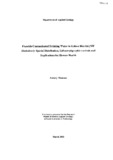Please use this identifier to cite or link to this item:
https://cris.library.msu.ac.zw//handle/11408/915| Title: | Fluoride contaminated drinking water in Gokwe District (NW Zimbabwe): spatial distribution, lithostratigraphic controls and implications for human health | Authors: | Mamuse, Antony | Keywords: | Fluoride-rich water, fluorosis, fluorine and human health. | Issue Date: | 2003 | Publisher: | Curtin University | Abstract: | The supply of drinking water in Gokwe District (NW Zimbabwe) is almost entirely based on groundwater drawn from boreholes and open dug wells. In certain areas of the district, the occurrence of dental fluorosis has been linked to excessive fluoride in the water supplies. A high prevalence of dental fluorosis (about 62%) was previously recorded among school children in the district. The aim of this study was to determine relationships between the spatial distribution of fluoride content in drinking water supplies in Gokwe, and lateral and vertical geological variation. A total of 224 water samples were collected from 196 water sources in the study area (a further 18 water sources just outside the study area were also sampled). All the samples were analysed for fluoride in the field using the fluoride ion selective electrode method (FISE). One hundred and fifty nine duplicate samples were analysed for fluoride and common anions and cations using High Performance Ion Chromatography (HPIC) in the laboratory. Two main groups of computer programmes were employed: (1) Geographic Information System (ArcView® GIS) was used to store, analyse and display multiple layers of surface geologic and geographic information, and (2) a three-dimensional visualisation programme (Rockworks) was used to interpret and illustrate site stratigraphy based on borehole information. Results indicated that the fluoride content of drinking water in the study area ranges from 0 to 9.65 mg/L. Forty-seven water sources (24%) yielded water containing fluoride in excess of the World Health Organisation's (WHO) health limit of 1.5 mg/L F. Of the 47 high fluoride water sources, 43 were boreholes (pumped or artesian). The shallower water sources (dug wells, streams and dams) largely yielded low-fluoride water. The groundwater fluoride contamination is stratigraphically controlled and originates from carbonaceous material (carbonaceous shales, carbonaceous mudstones and coaly material) within the Lower Madumabisa and Middle Wankie Members of the Lower Karoo Group. It has been shown that in general the greater the proportion of carbonaceous material intersected by a borehole, the greater the fluoride concentration of the water. Probable mineral sources of fluoride within the carbonaceous material include fluorapatite, kaolinite and trona. Chemical parameters that appear to influence the concentration of dissolved F in the water supplies include total dissolved solids (TDS), NaCl and pH. In relatively low fluoride waters, F concentrations generally increase with TDS and NaCl concentrations, whereas the highest F concentrations are found in moderately alkaline (pH 7.8-9) waters. Based on ranges of fluoride concentration in drinking water, fluorosis-risk zones were identified and have been illustrated on a fluorosis-risk map. The zones are: No Risk Zone (0-1.5 mg/L F), Moderate Risk Zone (1.5-3.0 mg/L F), High Risk Zone (3.0-6.0 mg/L F) and the Very High Risk Zone (6.0-10.0 mg/L F). The map suggests that groundwater available to people occupying 3650 km z (60.8%) of the study area potentially contains excessive fluoride (F>1.5 mg/L), presaging the occurrence of dental fluorosis, skeletal fluorosis and crippling skeletal fluorosis in the area. Different strategies may be employed to ameliorate the fluoride problem in Gokwe. These include sinking new boreholes to optimal depths and in appropriate locations, promoting the use of surface water and shallow groundwater, resettlement and defluoridation. However in order to fully understand the problem and to prescribe these or other solutions more comprehensively, multi-disciplinary studies may be required. Such studies may consider isotopic dating of water to investigate any relationships between fluoride concentration and residence time of water, geochemical analyses of rocks and soils, detailed fluorosis epidemiology studies and test-scale defluoridation investigations. | Description: | Abstract | URI: | http://espace.library.curtin.edu.au:80/R?func=dbin-jump-full&local_base=gen01-era02&object_id=15235 |
| Appears in Collections: | Thesis |
Files in This Item:
| File | Description | Size | Format | |
|---|---|---|---|---|
| StreamGate.pdf | 461.37 kB | Adobe PDF |  View/Open |
Page view(s)
134
checked on Apr 4, 2025
Download(s)
54
checked on Apr 4, 2025
Google ScholarTM
Check
Items in MSUIR are protected by copyright, with all rights reserved, unless otherwise indicated.



